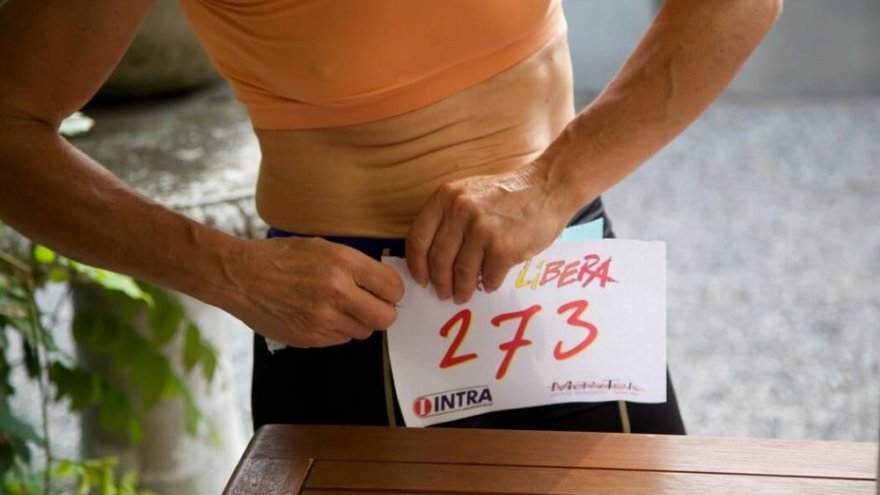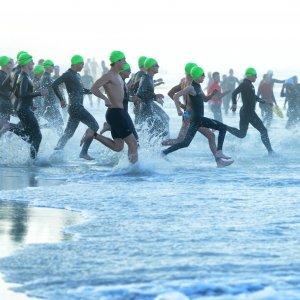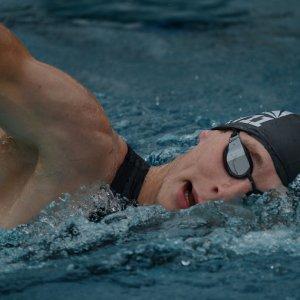What the Heck is an Aquathlon?

Marathon. Triathlon. Biathlon. Aquathlon…? Yep, you read that right. Other than being a mouthful, the aquathlon racing event is all the rage these days in the endurance sports world. The typical aquathlon is structured much like a triathlon is, consisting of three stages – yet there are only two sports involved. Participants start out with a run, then take to the water for a swim, then come back and finish up with a run. It is the “swimming sandwich” of endurance races if you will, and it is a ton of fun! (However, although not quite as common, some aquathlons are more simply structured to into just two sections for the run and the swim. But we happen to prefer the sandwich approach.)

Who Are They For?
Aquathlons are terrific options for those athletes who want to get into other endurance sports but want to progress slowly when taking on more than one discipline. They are also excellent options for people who are interested the triathlon field but do not have access to a bike, or for injured runners who take to the pool for recovery and training and find that they are not only strong runners but excel at swimming as well. And finally, aquathlons are great if you are simply looking to change things up or need an excuse to cross train to break up some of that lower body fatigue that comes with incessant running and training for running races.

What Will You Need to Train?
The downside of going from training for just running races to training for aquathlons comes with the need for additional equipment and unique training spaces. Obviously, in order to prepare yourself for race day, you will need to be able to practice your swimming in the months and weeks leading up to race day. If you sign yourself up for an open water race, that might take some additional training. My experience is that you do not necessarily have to train in open water for an open water race, but it can be helpful. First of all, you are able to see a lot less underwater in an open lake or body of water than you are a pool. That can make for some potentially-hazardous run-ins with other swimmers if you are not careful. Another reason is that open water swimming requires a keen sense of direction. If the race is put together well, there will likely be individuals along the water race route to help guide you, and buoys floating in the water to tell you where to swim and where to turn.
But in a pool, you are constantly swimming in one direction and you can zone out in your land. In open water, you have to constantly be mindful of where you are at, where other swimmers are around you, and be a strong enough swimmer to endure the whole race (you will not have the pool floor available to you to stop and stand on, obviously.) That is why it is good to at least practice a few times in an open body of water before race day, to try and prepare yourself for some of the conditions you could be exposed to. Going into any sort of water race without proper training can be dangerous, but when you are surrounded by hundreds of other racers kicking and stroking their legs and arms in a murky lake, you can quickly get lost in the pack.
If you already belong to a gym that has a pool, then start there. Otherwise, most towns have a YMCA or aquatic complex with open swim times for swimmers to come and swim laps. If you are training during the summer, there are even more options for lap swimming in public pools and even open bodies of water. Be mindful though, that you will also need to invest in a few quality pieces of swimming gear. You will need a proper swimsuit, goggles, and likely a hair cap. (For the race itself, swimmers are usually provided a specifically colored race cap, which helps race coaches know who you are and to what group you belong to. As far as swimsuits are concerned, if you want to make swimming apart of your standard exercise routine, you are best off purchasing one that is specifically designed for lap swimming.
These are tighter than other swimsuits, and “hold everything in place.” However, for the race day itself, you do not really have time to change out of your swimming attire and into running attire. But running in a swimsuit is not exactly comfortable, and swimming in your running attire is not efficient. And this holds especially true for the aquathlons that are organized into the run-swim-run structure. This is when you would want to consider purchasing a triathlon suit. These are full body suits that wick moisture well, are aerodynamic and tight enough for swimming in, but comfortable enough (i.e. avoiding chafing) to run in. As an added bonus, they are typically designed to have special pouches and pockets to hold any of your essentials (like a fuel belt, water bottles, and snacks).

How Should You Train?
If you decide to sign up for an aquathlon, you will also want to familiarize yourself with the transition time between the running and swimming events. A lot of racers lose time during this period because they are unprepared. When you exit the water, you will have an area assigned to you, where you can place your shoes, a towel, and any other equipment you might need to continue the race (if you are participating in a full triathlon, you would also put your bike here). To prepare yourself for an aquathlon, practice your transitions. This means that you can’t necessarily break your training up into specific run days and swim days.
You will need to have a few days of training in which you perform what is known as a brick workout, in which you perform multiple sports (to simulate race day). This allows you to practice transitioning from the swim, quickly drying off your feet and throwing your shoes on, and hopping straight into your run. It is also helpful because going from the motion of freestyle swimming to running can feel odd for your body – so it is best to get used to it before race day. And if you intend to have a fueling strategy on race day, make sure you try it out beforehand during your training. There might not be anything more frustrating than the wrong food and beverages being what derails you during your first aquathlon!
Latest Articles
 Is Running on a Treadmill Easier Than Running Outside?Runners have their own preferences, whether it is treadmill running, running outside on the road, or exploring trails. So...
Is Running on a Treadmill Easier Than Running Outside?Runners have their own preferences, whether it is treadmill running, running outside on the road, or exploring trails. So... Is It OK to Use Trail Running Shoes on the Road?While trail running shoes can be used on roads, especially in situations where a runner encounters mixed terrains or pref...
Is It OK to Use Trail Running Shoes on the Road?While trail running shoes can be used on roads, especially in situations where a runner encounters mixed terrains or pref... How to Fix Sore Quads After Running?Rest, ice, gentle stretching, and over-the-counter pain relievers can help soothe sore quads after running. Also, ensure ...
How to Fix Sore Quads After Running?Rest, ice, gentle stretching, and over-the-counter pain relievers can help soothe sore quads after running. Also, ensure ... 10 Fruits With The Most Electrolytes to Replace Sports DrinksThese fruits are high in electrolytes such as potassium, magnesium, and calcium, essential for hydration, muscle function...
10 Fruits With The Most Electrolytes to Replace Sports DrinksThese fruits are high in electrolytes such as potassium, magnesium, and calcium, essential for hydration, muscle function...

